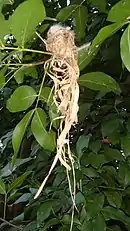Bee hummingbird
The bee hummingbird, zunzuncito or Helena hummingbird (Mellisuga helenae) is a species of hummingbird which is the world's smallest bird.[2][3] It is native to Cuba.
| Bee hummingbird | |
|---|---|
_immature_male.jpg.webp) | |
| Immature male | |
_female_in_flight.jpg.webp) | |
| Female in flight Both at Palpite, Cuba | |
| Scientific classification | |
| Kingdom: | Animalia |
| Phylum: | Chordata |
| Class: | Aves |
| Order: | Apodiformes |
| Family: | Trochilidae |
| Genus: | Mellisuga |
| Species: | M. helenae |
| Binomial name | |
| Mellisuga helenae (Lembeye, 1850) | |
Description
The bee hummingbird is the smallest living bird.[2] Females weigh 2.6 g (0.092 oz) and are 6.1 cm (2.4 in) long, and are slightly larger than males, with an average weight of 1.95 g (0.069 oz) and length of 5.5 cm (2.2 in).[4] Like all hummingbirds, it is a swift, strong flier.
The male has a green pileum and bright red throat, iridescent gorget with elongated lateral plumes, bluish upper parts, and the rest of the underparts mostly greyish white.[2][5] Compared to other small hummingbirds, which often have a slender appearance, the bee hummingbird looks rounded and plump.
Female bee hummingbirds are bluish green with a pale gray underside. The tips of their tail feathers have white spots. During the mating season, males have a reddish to pink head, chin, and throat. The female lays only two eggs at a time, each about the size of a coffee bean.[2]
The brilliant, iridescent colors of the bee hummingbird's feathers make the bird seem like a tiny jewel. The iridescence is not always noticeable, but depends on the viewing angle. The bird's slender, pointed bill is adapted for probing deep into flowers. The bee hummingbird feeds mainly on nectar, by moving its tongue rapidly in and out of its mouth. In the process of feeding, the bird picks up pollen on its bill and head. When it flies from flower to flower, it transfers the pollen. In this way, it plays an important role in plant reproduction. In one day, the bee hummingbird may visit 1,500 flowers.[6]
Diet
The bee hummingbird has been reported to visit 10 plant species, nine of them native to Cuba. These flowers include Hamelia patens (Rubiaceae), Chrysobalanus icaco (Chrysobalanaceae), Pavonia paludicola (Malvaceae), Forsteronia corymbosa (Apocynaceae), Lysiloma latisiliquum (Mimosaceae), Turnera ulmifolia (Passifloraceae), Antigonon leptopus (Polygonaceae), Clerodendrum aculeatum (Verbenaceae), Tournefortia hirsutissima (Boraginaceae), and Cissus obovata (Vitaceae).[7] They occasionally eat insects and spiders. In a typical day, bee hummingbirds will consume up to half their body weight in food.
Habitat and distribution
The bee hummingbird is endemic to the entire Cuban archipelago, including the main island of Cuba and the Isla de la Juventud in the West Indies.[4] Its population is fragmented, found in Cuba's mogote areas in Pinar del Rio province [8] and more commonly in Zapata Swamp (Matanzas province) and in eastern Cuba, with reference localities in Alexander Humboldt National Park and Baitiquirí Ecological Reserve (Guantanamo province) and Gibara and Sierra Cristal (Holguin province).[9]
Breeding

The bee hummingbird's breeding season is March–June. They lay up to two eggs at a time.[10] Males in the “bee” hummingbird clade court females with sound from tail‐feathers, which flutter during display dives.[11]
Using bits of cobwebs, bark, and lichen, the female builds a cup-shaped nest that is about 2.5 cm (0.98 in) in diameter. Nests have been built on single clothespins. She lines the nest with soft plant fibers and there she will lay her eggs. She alone incubates the eggs and raises the young.
Coevolution with flowers
The bee hummingbird interaction with the flowers that supply nectar is a notable example of bird–plant coevolution with its primary food source (flowers for nectar).[2][3]
See also
- Hummingbird moth
- Dinosaur size - the bee hummingbird is the smallest known dinosaur
References
- BirdLife International (2016). "Mellisuga helenae". IUCN Red List of Threatened Species. 2016. doi:10.2305/IUCN.UK.2016-3.RLTS.T22688214A93187682.en.CS1 maint: uses authors parameter (link)
- Simon, Matt (10 July 2015). "Absurd Creature of the Week: The World's Tiniest Bird Weighs Less Than a Dime". Wired. Retrieved 8 March 2017.
- Dalsgaard, B; Martín González, A. M.; Olesen, J. M.; Ollerton, J; Timmermann, A; Andersen, L. H.; Tossas, A. G. (2009). "Plant-hummingbird interactions in the West Indies: Floral specialisation gradients associated with environment and hummingbird size". Oecologia. 159 (4): 757–66. doi:10.1007/s00442-008-1255-z. PMID 19132403.
- Adrienne Glick. "Mellisuga helenae". Animal Diversity Web. Retrieved 19 June 2017.
- T. S. Schulenber, ed. (2010). "Bee Hummingbird, Mellisuga helenae". Ithaca, NY: Neotropical Birds Online, Cornell University Laboratory of Ornithology. Retrieved 8 March 2017.
- Piper, Ross (2007). Extraordinary Animals: An Encyclopedia of Curious and Unusual Animals'. Greenwood Press. p. 114. ISBN 978-0313339226.
- Dalsgaard, Bo, et al. "Floral traits of plants visited by the bee hummingbird (Mellisuga helenae)". Ornitologia Neotropical 23.1 (2012): 143–149.
- Ibarra, Elena. "Bird Surveys In The Mogote Vegetational Complex In The Sierra Del Infierno, Pinar del Rio, Cuba, June 2000". El Pitirre: 7.
- Navarro, Nils (2015). Endemic Birds of Cuba. A Comprehensive Field Guide. Ediciones Nuevos Mundos. pp. 56–57. ISBN 978-0-9909419-1-0.
- Martínez García, Orestes; Bacallao Mesa, Loraiza; Nieves Lorenzo, Elio (1998). "Estudio preliminar de la conducta reproductiva de Mellisuga helenae (Aves, Apodiformes) en condiciones naturales" [Preliminary study on the reproductive behaviour of Mellisuga helenae (Aves, Apodiformes) in natural conditions]. El Pitirre (in Spanish) (Winter): 102–106.
- Clark, Christopher J.; McGuire, Jimmy A.; Bonaccorso, Elisa; Berv, Jacob S.; Prum, Richard O. (2018). "Complex coevolution of wing, tail, and vocal sounds of courting male bee hummingbirds". Evolution. 72 (3): 630–646. doi:10.1111/evo.13432. ISSN 1558-5646. PMID 29380351.
External links
| Wikispecies has information related to Mellisuga helenae. |
| Wikimedia Commons has media related to Mellisuga helenae. |
- Bee Hummingbird videos, photos & sounds on the Internet Bird Collection
- Bee Hummingbird photo gallery VIREO
- Article with synopsis (with photos); Photo
- BeautyofBirds / Avian Web - Bee Hummingbird
- ARKive Bee Hummingbird Fact File

_adult_male_non-breeding.jpg.webp)
_adult_male_in_flight-cropped.jpg.webp)